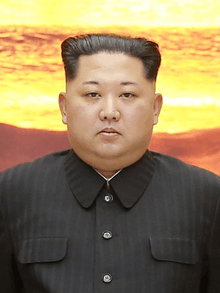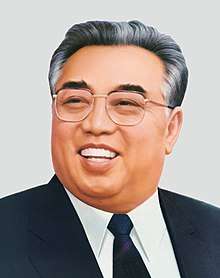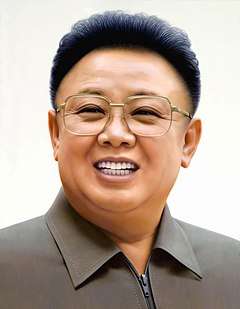Supreme Commander of the Armed Forces of North Korea
The Supreme Commander of the Armed Forces of Democratic People's Republic of Korea (Korean: 조선민주주의인민공화국무력 최고사령관) is the commander-in-chief of the Korean People's Army, the military of North Korea. The position is vested in the Chairman of the State Affairs Commission in accordance to Article 103 of the Constitution of North Korea.[1]
| Commander-in-chief role | |
 | |
| Korean People's Army | |
| Vested in | Chairman of the State Affairs Commission |
|---|---|
| Style | Comrade Supreme Commander |
| Residence | Pyongyang, North Korea |
| Formation | 8 February 1948 |
| First | Choe Yong-gon |
| Supreme Commander of the Armed Forces of North Korea | |
| Chosŏn'gŭl | 조선민주주의인민공화국무력 최고사령관 |
|---|---|
| Hancha | 朝鮮民主主義人民共和國 武力 最高司令官 |
| Revised Romanization | Joseonminjujuuiinmingonghwagug mulyeogchongsalyeong-gwan |
| McCune–Reischauer | Chosŏnminjujuŭiinmin'gonghwaguk muryŏkch'ongsaryŏnggwan |
History
The position was first known as the Chief Commander of the Korean People's Army (Korean: 조선인민군 총사령관) which was established on 8 February 1948 along with the founding of the Korean People's Army. Minister of National Defense Choe Yong-gon was appointed to this position.
On 4 July 1950, the Standing Committee of the Supreme People's Assembly issued a decree which created the position Supreme Commander of the Korean People's Army (Korean: 조선인민군 최고사령관) with Kim Il-sung being appointed to the position.[2] This was part of the reorganization of the Korean People's Army during the North Korean invasion of South Korea at the initial stages of the Korean War.[3]
Following the end of the Korean War, Kim Il-sung continued to exercise his powers as KPA Supreme Commander.
A new constitution was adopted in 1972 which stated that the President of North Korea is the supreme commander of the country's armed forces as well as the Chairman of the National Defense Commission.
On 24 December 1991, Kim Jong-il was appointed as the KPA Supreme Commander at the 19th plenary session of the 6th Central Committee of the Workers' Party of Korea. This appointment was part of the succession of Kim Jong-il, who was elected to the position of first vice chairman of the National Defense Commission on 22 May 1990.
Following Kim Jong-il's appointment as KPA Supreme Commander, a 1992 constitutional amendment removed any mention of the position of supreme commander. The amendment stated instead that the Chairman of the National Defense Commission has the power to command the country's armed forces. It also stated that the President is not automatically the Chairman of the National Defense Commission. This allowed for Kim Jong-il's election as Chairman of the National Defense Commission on 9 April 1993.
A 2009 constitutional amendment mentioned the position of supreme commander again and vested it in the Chairman of the National Defense Commission.
Kim Jong-il served as supreme commander until his death on 17 December 2011. Following this, Kim Jong-un was appointed as KPA Supreme Commander on 30 December 2011 by the Political Bureau of the Central Committee of the Workers' Party of Korea in accordance to Kim Jong-il's final instructions. At the time of his appointment as KPA Supreme Commander, he was the vice chairman of the Central Military Commission of the Workers' Party of Korea.
On 13 April 2012, the constitution was amended to transfer the powers of supreme commander to the First Chairman of the National Defense Commission to which Kim Jong-un was elected. Kim Jong-un was later elected as Chairman of the State Affairs Commission on 29 June 2016 to which the powers of supreme commander were transferred to.
The constitution was revised on 12 April 2019 which replaced the mention of "supreme commander" with "commander-in-chief."
On 15 April 2015, Kim Jong-un began to be referred to as Supreme Commander of the Armed Forces of the Democratic People's Republic of Korea despite the constitution designating him as commander-in-chief of the country's armed forces.
Powers
The North Korean constitution gives the Supreme Commander with the power to command the entire armed forces of the country.
Aside from issuing orders, the specific powers of the Supreme Commander are unknown.
Starting in 2018, Kim Jong-un stopped issuing orders in the name of the Supreme Commander. Instead, he issues orders for the North Korean military in the name of the Chairman of the Central Military Commission of the Workers' Party of Korea.
List of officeholders
| No. | Portrait | Name (Born-Died) |
Term | Political Party | ||
|---|---|---|---|---|---|---|
| Took office | Left office | Time in office | ||||
| Chief Commander of the Korean People's Army (8 February 1948 – 4 July 1950) | ||||||
| 1 | Vice Marshal Choe Yong-gon 최용건 (1900–1976) | 8 February 1948 | 4 July 1950 | 1 year, 305 days | Workers' Party | |
| Supreme Commander of the Korean People's Army (4 July 1950 – 15 April 2019) | ||||||
| 2 | Generalissimo of the DPRK Kim Il-sung 김일성 (1912–1994) | 4 July 1950 | 24 December 1991 | 41 years, 172 days | Workers' Party | |
| 3 | Generalissimo of the DPRK Kim Jong-il 김정일 (1941–2011) | 24 December 1991 | 17 December 2011 † | 19 years, 358 days | Workers' Party | |
| Vacant (17 December 2011 – 30 December 2011) | ||||||
| 4 | Marshal of the DPRK Kim Jong-un 김정은 (born 1984) | 30 December 2011 | 15 April 2019 | 7 years, 106 days | Workers' Party | |
| Supreme Commander of the Armed Forces of the Democratic People's Republic of Korea[4] (15 April 2019 – present) | ||||||
| (4) | Marshal of the DPRK Kim Jong-un 김정은 (born 1984) | 15 April 2019 | Incumbent | 1 year, 72 days | Workers' Party | |
References
- "Socialist Constitution - Chairman of the State Affairs Commission - Article 103". Naenara. Government of the Democratic People's Republic of Korea.
- "The Political Situation in Korea During the Period of Military Operations". Wilson Center Digital Archive. Retrieved 26 May 2020.
- Wada, Haruki (2018). The Korean War: An International History. Rowman & Littlefield. p. 99. ISBN 9781538116425.
- Yonhap (16 April 2019). "NK leader newly called 'supreme commander of Armed Forces of DPRK'". koreaherald.com. Herald Corporation. The Korea Herald. Retrieved 11 May 2020.


.jpg)